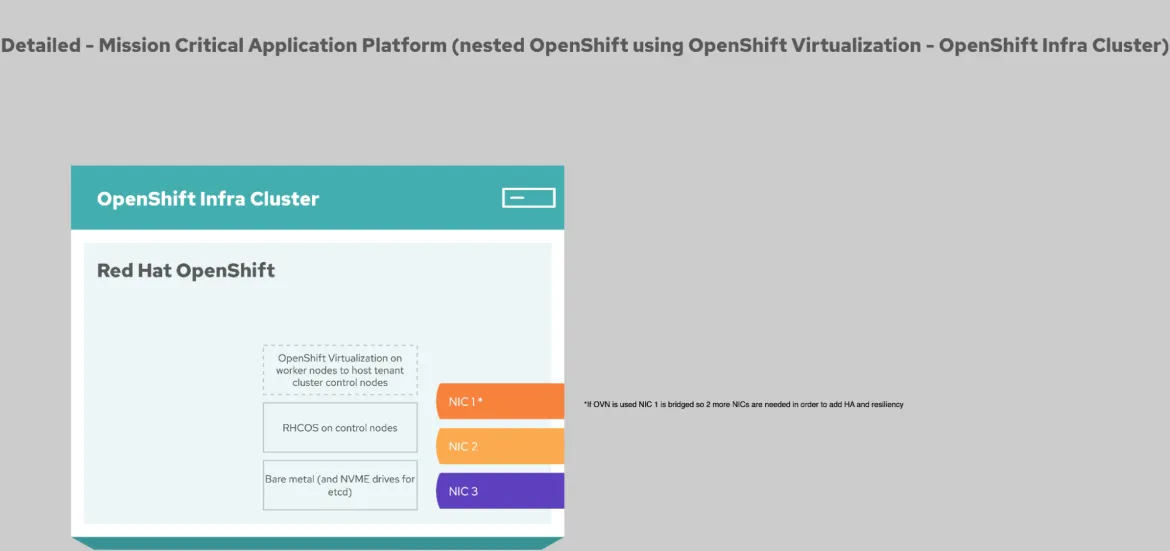Organizations need highly resilient application platforms to run their mission critical applications and facilitate developer innovation. They need the flexibility to scale as necessary while also operating within rigid regulatory compliance and security frameworks. And of course, all of this needs to happen while keeping operational costs low.
Red Hat has a solution designed to provide a modern infrastructure and application platform while also helping to drive the scalability and resiliency required to grow your business. It can provide many of the requisite tools to build automation, which in turn can help reduce ongoing maintenance costs. This has the dual benefit of also providing the configuration management needed to help environments stay consistent and in compliance with policies.

Figure 1 - Mission critical application architecture diagram
Let’s take a look at the Red Hat architecture designed to help you address these challenges.
Infrastructure clusters
This “OpenShift on OpenShift” solution provides high resiliency with a short recovery time from failures. The solution starts with a bare metal Red Hat OpenShift infrastructure cluster.

Figure 2 - Infrastructure cluster schematic diagram
The infrastructure cluster is a single rack of servers dual-homed to a pair of top of rack switches. The bare metal OpenShift installation consists of three control nodes and three worker nodes. The worker nodes will not host the application workloads— instead they will use OpenShift Virtualization to host virtual machines (VMs) which will run the tenant OpenShift clusters.
Tenant clusters

Figure 3 - Schematic diagram including tenant cluster
Multiple OpenShift clusters will run in the VMs on the infrastructure clusters. The three virtualized control nodes for each tenant cluster run on separate infrastructure clusters. Multiple tenant clusters running across the infrastructure cluster triplet helps isolate any damage in case of failures. The bare metal worker nodes for the tenant clusters, where the applications will be run, can be provided by the application teams. This allows them to optimally size their applications and better serve their requirements.
Automation
Utilizing a strict GitOps deployment strategy, where everything done to deploy and operate a cluster is conducted in code, enables this solution to scale as needed. This also enables shorter recovery times in case of a failure and allows faster upgrades via rebuilds.
The automated deployment is facilitated by Red Hat Ansible Automation Platform. All configuration updates are done through an API, including external dependencies (dhcp, dns, bgp, IDM, etc). This can all be automated with Ansible Automation Platform.
Configuration management is done via Red Hat Advanced Cluster Management for Kubernetes. This helps maintain greater consistency and compliance with policies and helps small site reliability engineering (SRE) teams manage at scale.
The overall solution reduces the burden on site reliability engineers in a number of ways. It creates a single pane of glass to simplify management, it provides for zero downtime upgrades via rebuilds and more resilient application design, and it enables rapid deployment, all while enabling a unified application deployment experience.
Summary
Utilizing this highly available architecture along with automation and GitOps practices will help lower maintenance costs while providing a more resilient platform for application modernization and innovation. If you'd like to take a closer look at how some Red Hat customers are using this solution, check out this architecture in full.
About the author
Chris Henderson is a Senior Product Manager for Red Hat Insights focusing on security services. In his time with Red Hat he has filled a variety of technical roles working with customers across a broad swath of industries. Chris leverages that broad experience and security focus to build products which help customers to meet their security and compliance needs.
Browse by channel
Automation
The latest on IT automation for tech, teams, and environments
Artificial intelligence
Updates on the platforms that free customers to run AI workloads anywhere
Open hybrid cloud
Explore how we build a more flexible future with hybrid cloud
Security
The latest on how we reduce risks across environments and technologies
Edge computing
Updates on the platforms that simplify operations at the edge
Infrastructure
The latest on the world’s leading enterprise Linux platform
Applications
Inside our solutions to the toughest application challenges
Original shows
Entertaining stories from the makers and leaders in enterprise tech
Products
- Red Hat Enterprise Linux
- Red Hat OpenShift
- Red Hat Ansible Automation Platform
- Cloud services
- See all products
Tools
- Training and certification
- My account
- Customer support
- Developer resources
- Find a partner
- Red Hat Ecosystem Catalog
- Red Hat value calculator
- Documentation
Try, buy, & sell
Communicate
About Red Hat
We’re the world’s leading provider of enterprise open source solutions—including Linux, cloud, container, and Kubernetes. We deliver hardened solutions that make it easier for enterprises to work across platforms and environments, from the core datacenter to the network edge.
Select a language
Red Hat legal and privacy links
- About Red Hat
- Jobs
- Events
- Locations
- Contact Red Hat
- Red Hat Blog
- Diversity, equity, and inclusion
- Cool Stuff Store
- Red Hat Summit

